
Podolepis is a genus of flowering plants in the tribe Gnaphalieae within the family Asteraceae. It is endemic to Australia and can be found in every state.
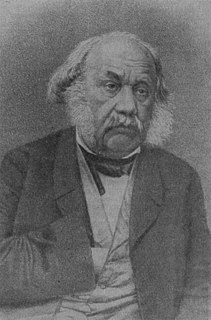
Nikolai Stepanovich Turczaninow was a Russian botanist and plant collector who first identified several genera, and many species, of plants.

Hardenbergia is a genus of three species of flowering plants in the pea family, Fabaceae and is endemic to Australia. Plants in this genus are climbing or trailing herbs or subshrubs with pinnate leaves with one, three or five leaflets and groups of violet, white or pinkish flowers in pairs or small clusters in leaf axils. Species of Hardenbergia occur in all Australian states and in the Australian Capital Territory.

Leucophyta is a plant genus which is endemic to Australia. The genus was first formally described by botanist Robert Brown in 1818.

The flora of Western Australia comprises 10,551 published native vascular plant species and a further 1,131 unpublished species. They occur within 1,543 genera from 211 families; there are also 1,317 naturalised alien or invasive plant species more commonly known as weeds. There are an estimated 150,000 cryptogam species or nonvascular plants which include lichens, and fungi although only 1,786 species have been published, with 948 algae and 672 lichen the majority.
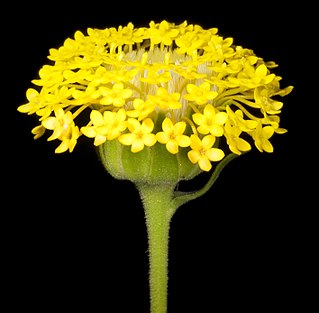
Podotheca is a genus of flowering plants in the tribe Gnaphalieae within the family Asteraceae. All species are endemic to Western Australia, except for Podotheca angustifolia which occurs across the south of Australia.
Millotia is a genus of small annual herbs in the tribe Gnaphalieae within the family Asteraceae.
Acomis is a genus of flowering plants in the family Asteraceae described as a genus in 1867. The entire genus is endemic to Australia. It was first described and published in Fragm. Vol.2 on page 89 in 1860.
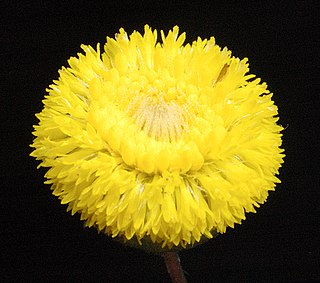
Panaetia, a genus in the Asteraceae (daisy) family, was first described by Henri Cassini in 1829 It is considered by Plants of the World Online and the Global Compositae Database to be a synonym of Podolepis Labil,. while GBIF states it as "doubtful". However, in 2021, the Western Australian Herbarium accepted Jeffery Jeanes new circumscription of the genus, together with two species of Panaetia as being found in Western Australia: Panaetia lessonii, and Panaetia tepperi. Jeanes distinguished Panaetia from the genera, Podolepis, Siemssenia and Walshia, using the following characters:
- the outer florets are all tubular; and
- the cypselas are minutely tuberculate and lack long finger-like papillae.
Olearia revoluta is a plant species in the sunflower family, Asteraceae, that is endemic to Western Australia.
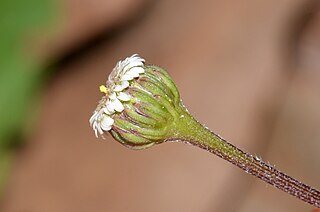
Lagenophora huegelii is a species of flowering plant in the daisy family (Asteraceae) which is endemic to Western Australia. It was formerly considered to also grow in eastern Australia and Tasmania, though these populations are considered a separate species: Lagenophora gunniana.

Podolepis canescens is a herb in the Asteraceae family, which is found in South Australia, the Northern Territory, New South Wales and Victoria. PlantNet also states that it is found in Western Australia, but FloraBase states that the name is misapplied in Western Australia, based on Jeanes (2015).
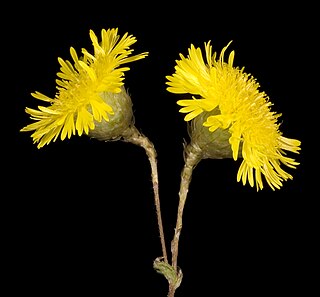
Podolepis aristata is a herb in the Asteraceae family, which is found in Western Australia, and all mainland states and territories of Australia.
Calotis pubescens is a species of daisy endemic to Australia and found in New South Wales and Victoria.
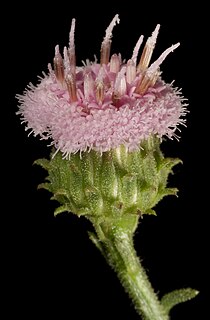
Pluchea dentex is a plant in the Asteraceae family, first described in 1867 by George Bentham, from specimens collected in Queensland by Robert Brown at Broad Sound and Thirsty Sound, by Ferdinand von Mueller at the source of the Gilbert River, and one by Eugene Fitzalan at Port Denison.

Olearia muelleri is a plant in the Asteraceae family. It was first described as Eurybia muelleri in 1853 by Otto Wilhelm Sonder. In 1867, George Bentham assigned it to the genus Olearia in his Flora Australiensis.

Olearia paucidentata is a plant in the Asteraceae family. It was first described as Eurybia paucidentata in 1845 by Joachim Steetz. In 1867, George Bentham assigned it to the genus Olearia in his Flora Australiensis.
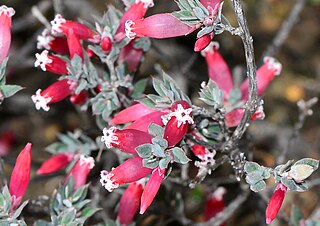
Styphelia stricta is a small plant in the family Ericaceae. It is endemic to Western Australia.
Millotia tenuifolia is a species of small annual herb in the tribe Gnaphalieae within the Asteraceae family, endemic to all states and territories of Australia except Queensland and the Northern Territory.
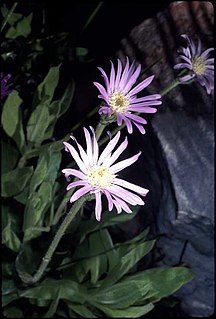
Olearia arguta is a species of flowering plant in the family Asteraceae and is endemic to northern Australia. It is an erect, hairy aromatic herb that typically grows to a height of up to 1 m and has oblong leaves, sometimes with a few pointed teeth near the end and produces white, blue, purple or pink daisy-like inflorescences. It was first formally described in 1867 by George Bentham from specimens collected on an island in the Gulf of Carpentaria by Robert Brown. The specific epithet (arguta) means "sharply-toothed".
















